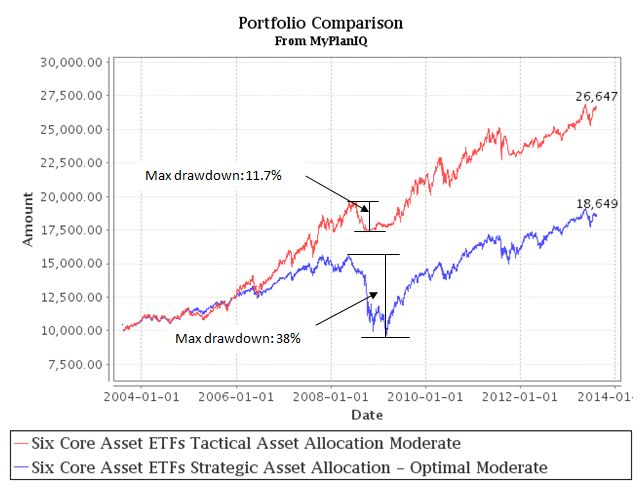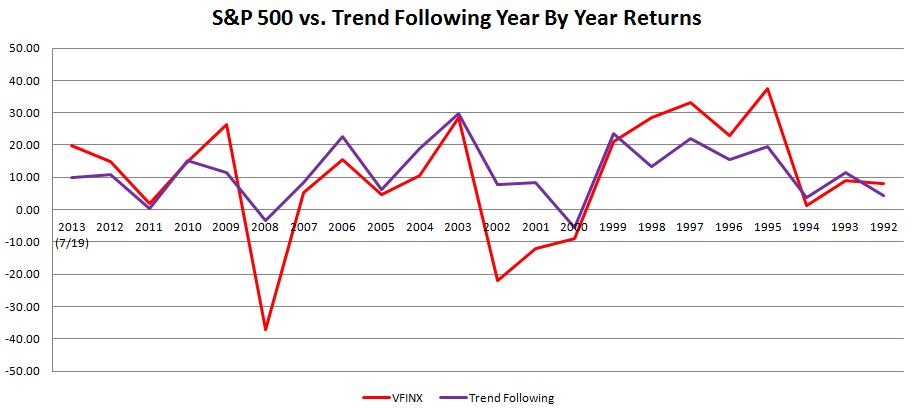Risk Management: Downside Risk
We have changed our logo’s tagline to ‘Risk Managed Investment Solutions’ to better reflect what we are doing. This newsletter is the 1st installment in the three parts of series that address different types of risks.
As what we stated numerous times before and stated in our mission statement:
As what Warren Buffett once said, “Rule No.1 is never lose money. Rule No.2 is never forget rule number one.”, we believe educating Americans on how to manage their investment risks is the most important task.
We further outline two ways to control risks:
Portfolio Diversification
Properly assessing personal risk tolerance and investing in a diversified portfolio are the key factors for long term investment success. Modern Portfolio Theory, backed by strong academic research and widespread practice, is the bedrock for strategic asset allocation. We provide strategic asset allocation portfolios that are tailored to investors’ personal risk profile (using proper stocks, bonds and cash allocations) for given 401k plans. MyPlanIQ has one of the largest 401k plan databases that is constantly updated by us as well as by our users.
Tactical Risk Reduction
Tactical asset allocation can be effective to reduce investment loss during a severe market stress. The strategy gauges current market condition and can dynamically shift risk exposure to avoid big loss. It has been proven by academic researchers and practiced by many wealth and investment managers. Adopting such a risk managed strategy enables investors to reduce a portfolio’s loss and fluctuation (volatility). This strategy has become more necessary in the coming decades to cope with increasing economic and financial market uncertainties.
When risk is mentioned, investors first think of downside risk. This is very natural as the purpose of investing is to grow your capital while in the meantime avoiding losing money.
Measures of downside risk
In today’s powerful computing and storage environment, there is no excuse not to understand your investment accounts (or in a fancy academic term, portfolios, we will use both interchangeably to get yourself familiar with the terms) using more scientific measures. It is despicable that many brokerages and 401k platforms do not provide well known and popularly used metrics for one’s accounts. In fact, we have found that many brokerages do not even provide return figures in their customers’ statements, let alone other metrics.
Nevertheless, if you are truly into investing, you should at least understand the following metrics that are often used to measure your account behavior, especially those that are related to risk:
- Standard deviation or volatility: without getting into actual mathematical definition (in fact, for most people, you don’t need to), standard deviation measures how much fluctuation (up and down) the total value of your account (or portfolio) in a period of time. Intuitively, the higher the standard deviation, the more volatile your portfolio.
- Now, combined with your account returns, you are faced with a question on how to measure which one is better. For example, if one portfolio returns 10% with 0.1 standard deviation while the other returns 20% with 0.3 standard deviation, which one is better for you? At first, you would say 20% is better for you. However, at least in theory, supposedly you can borrow money with zero interest rate (which is almost the environment we are in, isn’t it?), you can borrow 1x amount of money and get 2×10%=20% return with only 2×0.1=0.2 standard deviation. So you see this ‘leveraged’ portfolio actually achieves the same 20% as the 2nd. portfolio but with smaller standard deviation (0.2 vs. 0.3). In this sense, one can see that you would prefer the first portfolio (at least the strategy it uses) over the second one. This is exactly what a Sharpe ratio is about: it measures the return (above cash) per unit of standard deviation (or so called risk). Sometimes, this is also called risk adjusted return.
- However, standard deviation measures not only down volatility, it also measures up volatility. For example, if your portfolio always rises for any single day, but unfortunately, it rises at a very uneven fashion such as 3% one day, followed by 1% and then 5% etc., its standard deviation can be still as high as a portfolio that loses every single day such as -3% one day, -2% another and -5% etc. Certainly you would love to have the portfolio that always rises, care less about its uneven rise (at least in practice). To measure only the down side fluctuation, academic researchers introduce so called (downside) semi-variance. Again, you just need to understand its common sense: a measure for down side volatility only.
- Similar to Sharpe ratio, Sortino ratio is used to measure downside risk adjusted return. Well, again, all you care is the higher Sortino ratio, the better.
The above are the most popular popular metrics often cited in academia. However, practitioners also use the following two metrics to measure risk:
- Maximum drawdown — in a period of time, it measures the biggest percentage drop from the previous peak to a trough. This concept is hard to describe in mathematics but actually easier to understand intuitively: it is really a wealth effect measure: it measures how much wealth ‘loss’ phases one has to go through in this period. For example, if your portfolio rises from $10,000 in January to $20,000 in March and then it drops to $10,000 in May and then recovers back to $25,000 right now, its maximum drawdown would be (20,000-10,000)/20,000=50% because in May, you, as the owner of the portfolio, would think you had lost 50% of your money, measured from the highest point in March. This is sometimes also called ‘ulcer index’ by traders as high drawdown will cause more serious ulcer.
The follow chart compares the drawdowns of our two most standard portfolios:
Portfolio Performance Comparison (as of 8/12/2013)
| Ticker/Portfolio Name | 10 year Max Drawdown | YTD Return** |
1Yr AR | 3Yr AR | 5Yr AR | 5Yr Sharpe | 10Yr AR | 10Yr Sharpe |
|---|---|---|---|---|---|---|---|---|
| Six Core Asset ETFs Tactical Asset Allocation Moderate | 11.7% | 6.2% | 8.7% | 7.0% | 8.0% | 0.78 | 10.4% | 0.87 |
| Six Core Asset ETFs Strategic Asset Allocation – Optimal Moderate | 38% | 4.2% | 8.0% | 7.7% | 5.2% | 0.31 | 6.5% | 0.42 |
**YTD: Year to Date
- Multi-year (such as 5 or 10 years) Rolling returns — recently, in a financial advisor sponsored seminar, the advisor proudly announced that his clients’ portfolios have fully recovered from the loss in 2008-2009 and made some more money than in 2007. You also often hear financial media talk about permanent loss vs. temporary loss. In that, it basically says that as long as you didn’t sell in 2008, you did not incur permanent loss. On the other hand, in practice, if investors did need money from the portfolio in 2008 (such as a retiree’s portfolio that is needed for his short term spending) and withdrew from that portfolio, it will affect the portfolio more than the normal return indicates (see, for example, the S&P 500 portfolio case mentioned in July 8, 2013: When To Retire And Bear Market Impact On Retirement Income And Spending). A more meaningful way to measure such loss is to use multi-year rolling returns. This would assume that if an user starts to invest at the beginning of the multi-year (say 5 year period) and does not withdraw any money in the subsequent 5 years, how much returns a portfolio can have.
The following is the rolling 5 years returns between a trend following (tactical) portfolio and S&P 500 total return, taken from July 22, 2013: Tactical Asset Allocation: The Good, The Bad And The Ugly.
From the first chart, one can see that the tactical trend following portfolio does not have a single negative 5 year rolling return, compared with 4 negative returns for S&P 500. This indicates that the tactical portfolio is apparently better than S&P 500 buy and hold approach if money is needed in 5 years. However, the second chart also indicates that for a one year period, the tactical portfolio has at least 2 negative returns. This indicates that the portfolio is still not perfect for the money needed in one year, i.e. it is not a short term portfolio.
We believe that multi-year (n year) rolling returns are a very good indicator to measure whether a portfolio is a good portfolio for that period (n years). This measure would clear up the argument and confusion between long term and short term.
The downside risk of investment strategies
In general, as evident among the portfolios of all plans listed on MyPlanIQ.com, we can readily see that in a 5 year or longer period, Tactical Asset Allocation portfolios have better Sharpe ratios, Sortino ratios and maximum drawdowns than Strategic Asset Allocation. However, currently, in a shorter time frame, Strategic portfolios have done better. For further readings, we recommend
- July 29, 2013: Strategic Asset Allocation: The Good, The Bad And The Ugly
- July 22, 2013: Tactical Asset Allocation: The Good, The Bad And The Ugly
- July 8, 2013: When To Retire And Bear Market Impact On Retirement Income And Spending
- June 10, 2013: Risk Managed Strategic Asset Allocation Portfolios
- March 11, 2013: How To Evaluate Investing Strategies
- December 10, 2012: How Asset Allocation Strategies Performed In Secular Market Trends
- October 29, 2012: Sharpe, Maximum Draw Down And Sortino Ratios
- October 8, 2012: Asset Allocation Strategies Have Cycles Too
- September 10, 2012: Taxonomy Of Momentum, Relative Strength And Trend Following
However, downside risk is not the only factor one should consider when evaluating risk. We will address other equally important risk factors in the subsequent newsletters.
Market Overview
Both US stocks and international (developed country) stocks are hanging at the elevated levels. But other risk assets are not well: both REITs and Emerging market stocks are now ranked below cash, along with commodities. On the fixed income side, bonds are stabilized but still depressed. It is a tough environment going forward: rising rate, over valued and over bought. We call for caution for any new money to initiate new investments.
For more detailed asset class trends, see 360° Market Overview.
We again copy our position statements (from previous newsletters):
Our position has not changed: We still maintain our cautious attitude to the recent stock market strength. Again, we have not seen any meaningful or substantial structural change in the U.S., European and emerging market economies. However, we will let markets sort this out and will try to take advantage over its irrational behavior if it is possible.
We again would like to stress for any new investor and new money, the best way to step into this kind of markets is through dollar cost average (DCA), i.e. invest and/or follow a model portfolio in several phases (such as 2 or 3 months) instead of the whole sum at one shot.
Latest Articles
- Fund Flows: Investors Continued To Flee From Municipal Bonds
- AAII Asset Allocation Survey: Equities Allocation Is Just Above The Mean
- Thou Shalt Not Covet Thy Neighbor’s Tesla
- The Eerie Similarities Between 1987 and Today’s Stock Market
- Jesse Livermore: Parallels Between 1920s and Today
- Gold And Silver Stocks Down In 2Q 2013 Along With The Metals Themselves
- Young People Are Becoming More Optimistic While Older People Reducing Stock Exposure
- Anatomy of a Scam
- The Cost Matters Hypothesis Wins Again
- Dividend darlings can beat S&P 500 index
- Nice J.P. Morgan’s Asset Class Return Tables
- August 5, 2013: Total Return vs. High Yield Investing
Enjoy Newsletter
How can we improve this newsletter? Please take our survey
–Thanks to those who have already contributed — we appreciate it.




